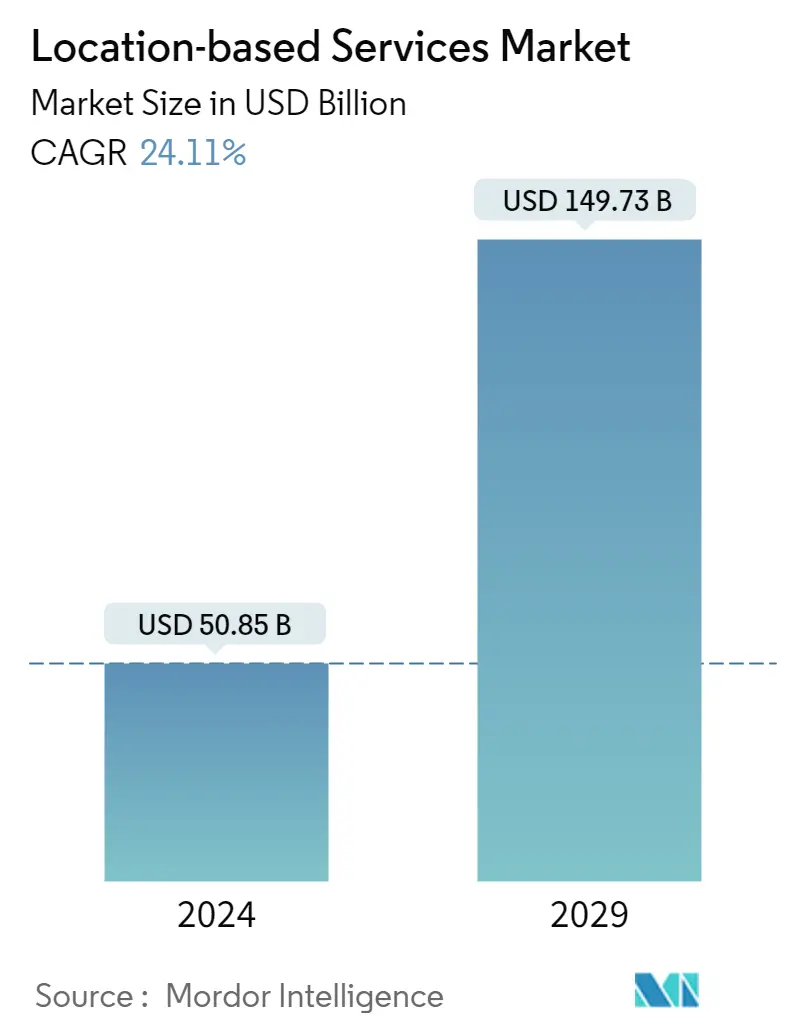Market Size of Location-based Services Industry

| Study Period | 2021 - 2029 |
| Market Size (2024) | USD 50.85 Billion |
| Market Size (2029) | USD 149.73 Billion |
| CAGR (2024 - 2029) | 24.11 % |
| Fastest Growing Market | Asia-Pacific |
| Largest Market | North America |
Major Players
*Disclaimer: Major Players sorted in no particular order |
Need a report that reflects how COVID-19 has impacted this market and its growth?
Location Based Services (LBS) Market Analysis
The Location-based Services Market size is estimated at USD 50.85 billion in 2024, and is expected to reach USD 149.73 billion by 2029, growing at a CAGR of 24.11% during the forecast period (2024-2029).
The proliferation of smartphone usage is driving the location-based services market.
- Location-based services (LBS) have emerged significantly during the past few years. It is increasingly being used to locate friends in an area, locate the nearest restaurant, or advertise deals to shoppers nearby. LBS gives users access to relevant and up-to-date information about their surroundings and allows businesses to update their customers regarding their orders. All these LBS applications offer a dynamic user experience, providing a convenient method for the interaction of business enterprises with customers.
- The fastest-developing positioning methods are based on mobile positioning and satellite-based GPS. With more widespread methods, like global cell identity (CGICTA) and enhanced observed time difference (E-OTD), the practical precision falls in the range of 50-1000 m. These technologies provide end-users with opportunities based on the accuracy required for specific application location identification.
- Location can be determined by using E-OTD, observed timed difference of arrival (OTDOA), wireless-assisted GNSS (A-GNSS), and hybrid technologies, which combine A-GNSS with other standard technologies. Better location and accurate, speculated arrival times in real-time can be offered to commuters and service seekers using location-based services that track vehicular movement. This is expected to gain a significant market base, coupled with the countries' significant efforts worldwide in trying to achieve smooth transportation goals as a part of their smart city projects. These developments are expected to create increased opportunities, particularly in the Latin American and Asia-Pacific markets, over the forecast period.
- Furthermore, with the significant ongoing investments for the integration of 3D mapping applications with smartphones, market players, such as Nokia, Samsung, and other OEMs, are entering this market. Online web service providers, such as Amazon Inc. and Microsoft Corp., have also started offering 3D maps on their platforms. For instance, Parrot, a prominent player providing wireless devices for mobile phones, has positioned its consumer drones for 3D modeling, mapping, and agricultural uses. These instances are expected to drive market demand across emerging economies during the forecast period.
- Location-based services currently face tremendous risks from government policies and regulations on consumer privacy. Most software developers are becoming aware of the growing international privacy laws and industry self-regulation codes that govern its use.In November this year, Google agreed to pay around $392 million in a settlement with 40 states over allegations that the company tracked people through their devices after location tracking had been turned off.
- Also, the effects of COVID-19 on the location-based services market were not all the same. This was mostly because the pandemic had different effects on the industries that used the services. Overall, the market was impacted negatively, although a solid recovery is set to drive the demand for location-based services over the forecast period.
